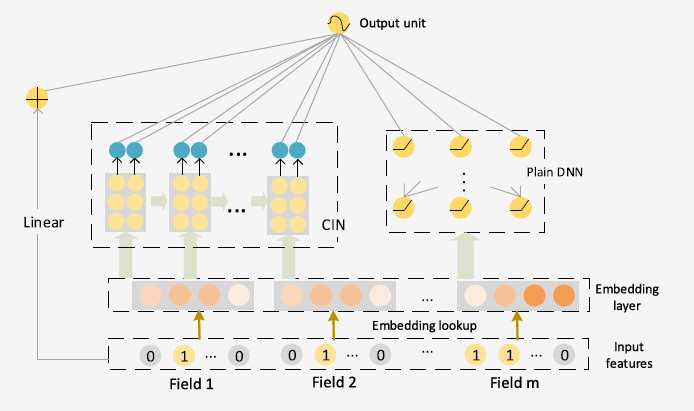xDeepFM¶
Introduction¶
Title: xDeepFM: Combining Explicit and Implicit Feature Interactions for Recommender Systems
Authors: Jianxun Lian, Xiaohuan Zhou, Fuzheng Zhang, Zhongxia Chen, Xing Xie, Guangzhong Sun
Abstract: Combinatorial features are essential for the success of many commercial models. Manually crafting these features usually comes with high cost due to the variety, volume and velocity of raw data in web-scale systems. Factorization based models, which measure interactions in terms of vector product, can learn patterns of combinatorial features automatically and generalize to unseen features as well. With the great success of deep neural networks (DNNs) in various fields, recently researchers have proposed several DNN-based factorization model to learn both low- and high-order feature interactions. Despite the powerful ability of learning an arbitrary function from data, plain DNNs generate feature interactions implicitly and at the bit-wise level. In this paper, we propose a novel Compressed Interaction Network (CIN), which aims to generate feature interactions in an explicit fashion and at the vector-wise level. We show that the CIN share some functionalities with convolutional neural networks (CNNs) and recurrent neural networks (RNNs). We further combine a CIN and a classical DNN into one unified model, and named this new model eXtreme Deep Factorization Machine (xDeepFM). On one hand, the xDeepFM is able to learn certain bounded-degree feature interactions explicitly; on the other hand, it can learn arbitrary low- and high-order feature interactions implicitly. We conduct comprehensive experiments on three real-world datasets. Our results demonstrate that xDeepFM outperforms state-of-the-art models.

Quick Start with RecBole¶
Model Hyper-Parameters:
embedding_size (int): The embedding size of features. Defaults to10.mlp_hidden_size (list of int): The hidden size of MLP layers. Defaults to[128,128,128].reg_weight (float): The L2 regularization weight. Defaults to5e-4.dropout_prob (float): The dropout rate. Defaults to0.2.direct (bool): Whether the output of the current layer will be output directly or not. When it is set toFalse, the output of the current layer will be equally devided into two parts, one part will be the input of the next hidden layer, and the other part will be output directly. Defaults toFalse.cin_layer_size (list of int): The size of CIN layers. Defaults to[100,100,100]
A Running Example:
Write the following code to a python file, such as run.py
from recbole.quick_start import run_recbole
run_recbole(model='xDeepFM', dataset='ml-100k')
And then:
python run.py
Tuning Hyper Parameters¶
If you want to use HyperTuning to tune hyper parameters of this model, you can copy the following settings and name it as hyper.test.
learning_rate choice [0.01,0.005,0.001,0.0005,0.0001]
dropout_prob choice [0.0,0.1,0.2,0.3,0.4,0.5]
mlp_hidden_size choice ['[64,64,64]','[128,128,128]','[256,256,256]','[512,512,512]']
cin_layer_size choice ['[60,60,60]','[80,80,80]','[100,100,100]','[120,120,120]']
reg_weight choice [1e-7,1e-5,5e-4,1e-3]
Note that we just provide these hyper parameter ranges for reference only, and we can not guarantee that they are the optimal range of this model.
Then, with the source code of RecBole (you can download it from GitHub), you can run the run_hyper.py to tuning:
python run_hyper.py --model=[model_name] --dataset=[dataset_name] --config_files=[config_files_path] --params_file=hyper.test
For more details about Parameter Tuning, refer to Parameter Tuning.
If you want to change parameters, dataset or evaluation settings, take a look at